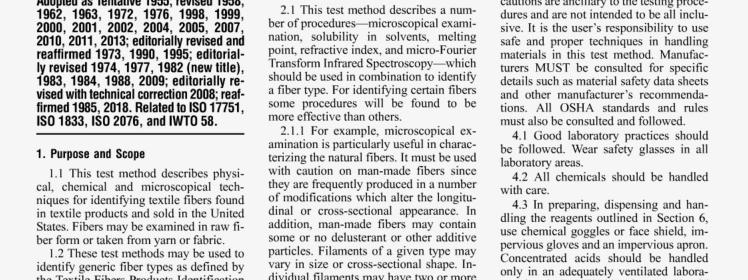Fiber Analysis: Qualitative

AATCC 20-2018 pdf free.Fiber Analysis: Qualitative.
Sulfuric acid solution. 59.5 ± 0.25% by weight, density 1.4929 * 0.0027 g per ml at 20°C. Weigh into a bcakcr 59.5 g of conccntrated sulfuric acid (sp gr l.X4). Weigh into a 250 ml Erlcnmcycr flask 40.5 g of distilled water Cautiously add the acid to the waler swirling and cooling in ice water or under a lap. Hi’ar goggi& The solution becomes very hot and may boil and spatter if no cooled during mixing. After the solution has cooled to 20°C (6°F) adjust thc density to a value between 1.4902 and 1.4956 g per ml.
Sulfuric acid solution, (70±1% by weight, density 1.6105±0.0116 g per mL at 20°C’). Weigh 70 g of concentrated sulfuric acid (sip gr l.X4) and 30 g of water and mix with the same precautions as in 6.5.10. After the solution has cooled to 20°C (6)1°F) adjust the density to a value between l.59X9 and 1,6221 gpcrmL.
m-Crcsol. reagent grade. Poisonous. Usc in ventilated hood.
Hydrofluoric acid. 49% reagent grade. Very dangerous. Use goggles and hood under suction. Do not inhale vapors or allow to contact skin.
To obtain a representative sample for identification it is necessary to consider the following:If the sample is loose fiber or yam. it may contain one fiber only or it may be an intimate blend of two or more fibers.
A yarn sample mas’ be a ply or wrapped core blend of two or more yams. These yarns in turn may be the same or different and may themselves contain a blend of fibers.
Woven or knitted fabrics may be constructed of yarns from one fiber type or from yarns made with muttiple fiber types. Further, fabrics may be made with yarns that have different individual fiber types or multiple fiber types in the length or width directions of the fabric construction, that may require separate analysis.
Different fiber types may be dyed to the same color. Contra,vwise. the same fiber type may appear in different colors in the finished article by mixing stock dyed or yam dyed materials or using fihers with modified dyeing characteristics.
In many cases the identity of an unknown fiber can be established without pretreatment.
When the presence of starch, wax. oil or other coating obscures the appearancc of the fibcr, try heating in wann to hot distilled water to remove the foreign matter. If this fails, try extracting with organic solvents. 0.5% hydrochloric acid or 0.5% sodium hydroxide. Some fibers such as nylon are damaged by acid and some such as ailon, silk and wool, arc damaged by caustic treatment (see 9.7).
To separate vegetable fiber bundles. treat with 0.5% sodium hydroxide solution, rinse well with water and dry.
To strip dye from colored fibers. especially the cellulosic fibers, heat for 30 mm at $0U with hydrosulfitc caustic solution (see 6.2.1).
The identification of fibers is usually carried out by subjecting specimens to a variety of selected tests until enough infonnation is obtained to make a satisfactory judgment as to the generic class or specific type. The selection of tests and order in siiich they are performed can change depending on the knowledge already available and results of the preliminary tests.
Visual and Microscopical Examination.
Examine the sample of material submitted for identification. Note form (loose fibers. yam, fabric. etc.). color. Ii- her length and fineness, uniformity of appearance and probable end-usc. If the sample is a fabric, separate out yams by unraveling or cutting. If the fabric is woven, separate warp and filling yams. If yams differ in color, luster. sire or other apparent ways, make a physical separation of these yarns for separate identification.
Thc fibers may be identified using either light or scanning electron microscopy. If using transmitted light microscopy, place a small quantity of the fibers on a gbs.s slidc, tease fibers apart, mount with a drop of mineral oil or other imtnersion fluid, cover with a cover slip and examine under the microscope.AATCC 20 pdf free download.Fiber Analysis: Qualitative